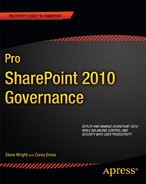Introduction to IT Management
Managing a SharePoint farm involves using the many tools available to manage the technology platform made up of the SharePoint server farm and the site content contained within the farm.
Managing a SharePoint server farm is similar to managing any other IT-related system. Requirements for performance, reliability, maintenance, and functionality must be established to implement the systems to support the needed functionality. These systems must be deployed, configured, monitored, backed up, and upgraded regularly. Service Level Agreements (SLA) often define these requirements and how they will be met. Chapter 7 will focus on the tools available on the SharePoint platform and how they can be used to manage the infrastructure provided by the SharePoint family of products. Chapter 8 will look at the creation of an Operations Plan for the SharePoint farm that defines which tools will be used and for what purposes.
In this chapter, we will focus on the content stored within a SharePoint server farm. We use the term content generically to refer to any new information that is introduced into the sites hosted on SharePoint by the end users. This may include calendars, announcements, documents, forms, and many other predefined or custom types of data objects. Interestingly, the most common types of content within SharePoint are often web sites and the web pages that make up those sites. From a more IT-centric point-of-view, SharePoint content is anything stored within SharePoint's content databases, which are relational data stores used to house all content in SharePoint. Of course, SharePoint does a great deal more than simply store content. (If storing content were the only requirement, a set of shared network folders would be just as useful as a SharePoint farm.) For example, SharePoint also has features that allow users to define metadata that describes the information and even actively route users to the information they need. These features will be examined in Chapters 9, 10, and 11 on information management.
The IT department is concerned with establishing the policies and standards that allow the users to leverage information management features without jeopardizing the integrity of the organization's data. The most important step is to define the structure of the content to be deployed and how it will be maintained. This includes managing how sites and other content are created, updated, and deleted by users of the system. SharePoint stores information at a variety of levels including site collections, sites, and list and library items, each of which has its own set of controls that can be applied as needed. This discussion will take a top-down approach by starting with the governance of the entire server farm and working our way down to describing some of the more important features available for managing the content lifecycle.
